Lecture
GUIDES ON CLOSED DOORS
The great Russian physiologists I. M. Sechenov and I. P. Pavlov attached great importance to muscular sensations arising from articulation. Sechenov wrote: "It even seems to me that I never think directly with a word, but always with muscular sensations." (I. Sechenov. Favor. Works. M. — L., Academy of Sciences of the USSR, 1952, Vol. 1, p. 87.)
Pavlov also said that speech is first of all the muscular sensations that flow from the speech organs to the cerebral cortex.
Therefore, in search of what can help in the development of a child’s speech, first of all the thought arose of using muscular sensations from the speech apparatus. But how to call them? We already know that in infants, onomatopoeia occurs only if the child sees the adult’s facial expressions and reproduces it. But we also know something else: by the age of seven months, imitation of mimicking in children is waning. It is very difficult for one-year-olds and older children, who are pedagogically run, to receive nerve impulses from organs of articulation. Therefore, this door remains closed, and we need to look for another.
If you look closely at the map of the brain (see Fig. 6), it is striking that the motor speech region is located very close to the motor region, it is, in fact, part of it. Maybe the development of motor speech depends on the development of the overall motility of the child as a whole?
Based on this assumption, the following observations were made. In the same house of the child we just talked about, 19 healthy, but non-speaking children were selected at the age of 1 year, 1 month - 1 year, 3 months. Nine of these children (we will call them the 1st group) were given the opportunity to move freely on the floor every day for 20 minutes (Fig. 43, 44).

Fig. 43. The child moves freely on the floor.
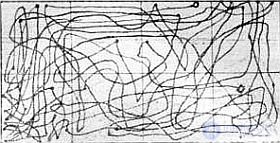
Fig. 44. The protocol of movement of the baby on the floor.
The remaining 10 children (group 2) were in normal conditions, i.e. they spent the waking period in the arena where their movements were restricted: wherever the child crawled (or went), he ran across the barrier or at other children. In both groups, two-minute speech development classes were held daily with each child, as described above.
It turned out that the children of the 1st group began to attempt to imitation during the classes on average on the 7th day, but these imitations were weak and stereotyped - for example, an adult said: “av-av”, “mu-mu”, “ha “ha,” and so on, and the child responded to everything with the same quiet sound “aaaa” or “yyy”. By the 20th day of training, attempts began to appear more accurate onomatopoeia.
In the second group, the voice reactions appeared on average on the 13th day, that is, two times later, they were also weak and inconstant and stereotypical; After 30 days of classes, no significant changes were noted.
When we compare the results obtained in both groups, we see that the possibility of free movement, which the children of the first group had, somewhat facilitated the occurrence of onomatopoeia. However, success was less than we expected. Obviously, this door was closed, and it was necessary to continue the search.
Returning to the anatomical relationship, we noticed that about a third of the entire area of the motor projection is occupied by the projection of the hand, located very close to the speech motor zone. Especially clearly a huge area of the projection of the brush is shown in Fig. 45.
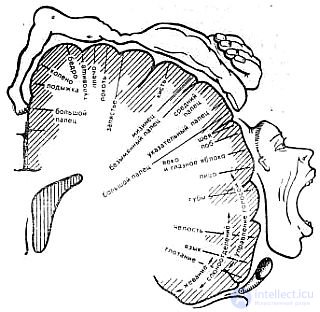
Fig. 45. Penfield man.
This is the so-called homunculus (man) Penfield. In it, the projections of all body parts in the motor area are shown not only by dashes (as in Fig. 7), but also in figurative form. It is the size of the projection of the hand and its proximity to the motor speech zone that suggested that the training of subtle movements of the fingers would have a greater impact on the development of the active speech of the child than the training of general motor skills.
To study this question, L. V. Fomin in our laboratory has done a great job. In the child’s home, three groups of children aged from 10 months to 1 year and 3 months were taken; in each group classes were conducted according to their own plan:
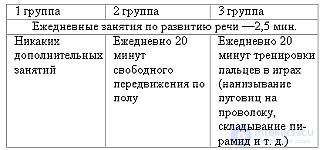
Probably, you already guessed, what results were obtained in the 1st and 2nd groups? In the 1st group, voice reactions began to receive on average on the 20th day, but they were weak and stereotyped. But the 2nd group of onomatopoeia attempts appeared on the 6th day, and after the 15th day in 10% of cases a fairly accurate reproduction of sounds was noted. The results obtained in the 3rd group were unexpected for us as well: voice responses were already received on the 3rd day; from the 7th day - in 41%, and from the 15th day - in 67.3% of cases it was already more correct onomatopoeia!
Thus, onomatopoeia during training of subtle movements of the fingers not only managed to get much earlier (7 times faster than in the 1st group!), But it turned out to be more perfect.
Interestingly, after a few days, the third group of children began to observe subtle movements of the fingers and hands outside of our classes: for example, the child would take a doll and touch its nose and eyes; he lifted a crumb of bread from the table, turned it, etc. (fig. 46).
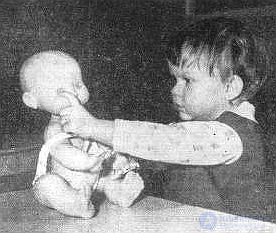
Fig. 46. Child (1 year 3 months) from the 3rd group (with training fingers movements). Touches the eye of the doll.
The children of the 1st and 2nd groups of small parts in objects were not distinguished, taking a toy, just knocking it or pulling it into their mouths.
Further, L.V. Fomina examined more than 500 children in various children's institutions and found that the level of speech development in them is always directly dependent on the degree of development of subtle movements of the fingers (it did not always coincide with the level of development of general motor skills). These relationships are shown in the table:
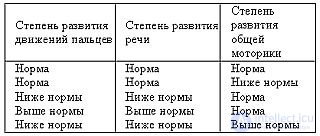
So, you see: if the development of finger movements corresponds to the age (norm), then the development of speech is also within the normal range, if the development of the fingers is lagging behind - the development of speech is also lagging behind, although the general motor skills may be within the normal range and even higher. Testing for a large number of children shows that this is not an accident, but a pattern.
Now, to determine the level of speech development, we conduct this experience with the children of the first years of life: we ask the child to show one finger, two fingers and three (“do it like this” —and show how to do it). Children who succeed in isolated finger movements are talking children;
if the fingers are tense, they only bend and unbend together or, on the contrary, are sluggish (“wadded”) and do not give isolated movements, then these are non-speaking children. Thus, without having heard a single word from a child, it is possible to determine how his speech is developed. Until the movements of the fingers become free, the development of speech cannot be achieved. It’s surprising, perhaps, not the fact of the influence of the movements of the fingers on the development of speech, as much as the fact that we haven’t been able to use it for so long.
The fact is that in neuropathology and defectology there have long been observations that spoke about the close connection of the functions of speech and hand. Thus, it was known for a long time that in trauma or hemorrhage in the speech motor area in the left hemisphere, a person not only loses speech, but also the subtle movements of the fingers of his right hand, although the area of the movement projection of the fingers itself was not affected. At the end of the last century, cases of lesion of the frontal region of the left hemisphere without loss of speech were described. When such cases were carefully studied, it turned out that these patients are left-handed and their motor speech area is in the right hemisphere 1 . The development of speech areas in the right or left hemisphere, depending on whether the person is left-handed or right-handed, especially convincingly shows the connection between the functions of speech and the hand. This is proven in the study of the structure of the brain. It has already been mentioned that in the right-handed child, during the first two years of life, there is an increased growth of the speech motor area and the maturation of cells in it in the left hemisphere, and in a left-handed person - in the right.
Very interesting observations made by defectologists. So, it is now precisely established that a crude remake of a left-handed person to a right-handed person (when a child is tied with his left hand behind his back, beaten on the arm, etc.) in most cases leads to stuttering and other speech disorders.
Convincing are also the facts obtained in teaching sound speech to deaf-and-dumb children. Some of these children are taught from an early age to communicate with other people using large gestures performed with the whole hand, others are taught the so-called dactyl (finger) alphabet when they use letters with their fingers and the child “writes” the words. When deaf-and-dumb children come to school and begin learning sound speech, it turns out that those who spoke with large gestures are more difficult to learn - it takes many months; the same children who previously spoke with fingers, very easily and quickly acquire sound speech.
When we compare all these facts, naturally, we come to the conclusion: speaking about the period of preparing a child for active speech, one must keep in mind not only the training of the articulatory apparatus, but also the movements of the fingers. The facts presented here, as it seems to us, make it possible to attribute the hand to the speech apparatus, and consider the motor projection area of the hand to be another speech area of the brain. So this is where the open door turned out to be, through which our “black cat” was able to reach - speech!
WHAT IS THE CONNECTION OF THE MOVEMENTS OF FINGERS AND SPEECH?
The movements of the fingers historically, in the course of human development, have been closely associated with the speech function.
The first form of communication primitive people were gestures, they gradually began to be combined with shouts, shouts. Thousands of years passed before verbal speech developed, but for a long time it was associated with gestural speech.
The very movements of the fingers gradually improved - from generation to generation, people performed more and more delicate and complex work. In connection with this, an increase in the area of the motor projection of the hand in the human brain occurred. So the development of the functions of hands and speech in people went in parallel.
Approximately the same is the course of the child’s speech. First, the movements of the fingers begin to develop, and when they reach sufficient subtlety, the development of verbal speech begins. The development of the movements of the fingers of the hands as it prepares the ground for the subsequent formation of speech.
In fig. 47 shows how the improvement of finger movements occurs with the age of children. Of particular importance is the period when the opposing of the thumb to the rest begins - from now on, subtle movements become accessible to the child.
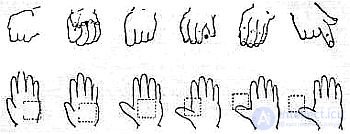
Fig. 47. Diagram of the development of thin movements of the fingers of a child’s hand (according to X. Halverson).
The top row of figures shows the complexity and improvement of the movements of the fingers: first, the whole palm and fingers act, the movements of the individual fingers are gradually singled out. The bottom row shows how the position of the captured object changes with the development of finger movements: at first it lies on the palm of your hand, and later - only at your finger tips.
Is it an accident that the training of movements somehow affects the maturation of the speech motor area? In order to answer this question, in our laboratory of L. A. Panashchenko such observations were made. In children at the age of six weeks, brain currents were recorded in the children's home, then in some of these children they trained their right hand, and in others they trained their left hand. The training consisted of hand massage and passive (i.e. adult-made) flexions and extensions of the fingers. One month and two months after the start of such training, the brain currents were re-recorded and the degree of stability in the appearance of high-frequency waves was mathematically calculated, which is an indicator of the degree of maturation of the cerebral cortex. It turned out that after a month of training, high-frequency rhythms began to be noted in the area of motor projections, and after two months - in the future speech region, in the hemisphere opposite to the trained hand!
A similar study (a monthly recording of brain biocurrents followed by mathematical analysis) was also conducted on a group of children of the same age with whom no training was conducted. The results obtained in these
Observations showed that training fingers for two and a half months accelerates the process of maturation of speech areas — in right-handed people in the left and in left-handed people in the right hemisphere! These data already directly indicate that the speech areas are formed under the influence of pulses from the fingers.
Naturally, this fact should be used in work with children and where speech development occurs in a timely manner, and especially where there is a lag, a delay in the development of the motor speech of children.
FINGERS HELP TO SPEAK
Finger training can begin with children between six and seven months. During this period, it is useful to do a massage - stroking the hands in the direction from the tips of the fingers to the wrist and exercises: take each finger of the child separately into his fingers, bend and straighten it. Doing so should be 2-3 minutes daily.
From the age of ten months you should give the child to sort through larger bright objects first, then smaller ones. For this purpose, good painted wooden beads strung on an elastic band (they are sold in toy stores); children willingly sorted out and ordinary beads, but there is a danger that the child can swallow the bead and choke.
Very good training of the movements of the fingers provide folk games with fingers. In addition to the well-known Soroki-Beloboki, the methodologists of the Leningrad Methodological Cabinet for pre-school education found several similar games. Three such games, selected by the methodologist A. S. Feldberg, are listed below.
"Fingers in the forest"
One, two, three, four, five
Keep your left hand in front of you with your palm.
Left fingers to walk.
This finger mushroom found
Bend the 5th finger of the left hand.
This finger began to clean,
Bend the 4th finger.
This cut,
Bend the 3rd finger.
This ate,
Bend the 2nd finger.
Well, this one just looked!
Bend the 1st finger and tickle the palm.
This game is conducted by an adult who bends the child's fingers and tickles his palm. The game is suitable for the smallest.
The following two games can be played with several children at the same time. This is a game for older children.
"Fingers"
This finger wants to sleep,
Children raise their left hand palm to themselves. With the right hand, hold the 5th finger of the left hand and bend it after the words "wants to sleep."
This finger went to bed.
Same with the 4th finger.
This finger has a little nap,
Hold the 3rd finger of the left hand and bend it after the words "a little nap."
This finger already fell asleep.
Same with the 2nd finger.
This is sound, sound asleep.
Same with the 1st finger. The right hand is lowered, the left fist is held.
Hush, hush, do not make noise!
The red sun will rise
Morning red will come,
There will be twitter birds,
There will be fingers to get up!
Raise your left hand and straighten your fingers with the word "stand up."
This game must be repeated, working with the fingers of his right hand.
"Fingers and Cams"
The children sit on chairs arranged in a semicircle. The teacher says:
- Once upon a time there was a little finger, a little one
Here it is, finger (shows), came to us.
He said hello - like this (finger bows) and asked in a thin voice:
“Are there any naughty guys?” (Answer: “Yes”).
And the naughty guys shocked (threatens) "You can not misbehave! It is impossible! "
- Ay, finger! You are very strict
- Look what kids are,
They play up quite a bit.
You do not be angry, you danced us.
(The finger makes a negative move).
- Do you want to dance? Why?
Probably boring alone.
Girls! Boys!
Do you have fingers?
(Children raise their hands and show fingers).
- Look how many fingers!
Who are you dancing with? Choose!
All, all dance, fingers!
Music, play!
(Music "Fingers are dancing").
- WOF WOF! Scared fingers.
Hid in a fist.
(All hide fingers, clenched fists).
Woof woof woof! Where are the fingers?
I can not find in any way!
Fingers bent, silent ...
And the cams as zastuchat!
(Music "Cams", all knock the fist on the fist).
- Scared dog and ran away.
(Fingers unbent).
Girls! Boys!
Where are your fingers?
Hid in a fist.
(All hide fingers in a fist).
- May! Me! Me!
I can not find in any way!
Fingers bent, silent ...
And the cams as zastuchat!
(Music "Cams", all knock the fist on the fist).
- The goat was frightened and ran away.
And fingers dance again
In girls and boys.
(Music "Fingers are dancing").
- So they stopped dancing ... So, they are tired.
Tired of the children came,
Under the cheeks lay
And fall asleep ...
(Music "Lullaby").
An excellent means for the development of finger movements is the game “Theater of Fingers” - children with a passion about one and a half years and older play it. Commercially available sets of “Theater of the Fingers” (there are two options) are the heads of animals and people who wear the fingers and with whom they play various scenes. Playing with children of the second or third year of life should be conducted with the participation of an adult — at this age, the children only repeat the movements of the fingers shown by the adults. Кроме того, они еще не в состоянии развивать сюжет такого «спектакля». Около четырех лет ребята начинают импровизировать некоторые простые сценки сами.
Нужно подчеркнуть, что такие игры не должны быть очень продолжительны. Как показывают наши наблюдения, 5 минут в день вполне достаточно для того, чтобы стимулировать речевую функцию ребенка.
Говоря о тренировке движений пальцев рук, нельзя не упомянуть о леворукости.
Левшей называют амбидекстрами, т. е. имеющими две правые руки. Действительно, левши обычно хорошо владеют обеими руками, поскольку сами они стремятся все делать левой рукой, а окружающие взрослые учат их владеть правой.
Плохо это или хорошо быть левшой? Скорее, хорошо: ведь при тренировке обеих рук речевые области будут формироваться в обоих полушариях мозга. Невропатологи считают это страховкой от потери речи при поражении левого полушария. И. П. Павлов полагал, что левши (именно благодаря наличию речевых областей и в правом, и в левом полушариях) имеют перед правшами преимущество в интеллектуальном развитии: он, в частности, указывал, что среди выдающихся людей было много левшей (сам И. П. Павлов тоже был левша).
Учитывая все это, мы считаем более правильным у всех детей стараться развивать обе руки — это только полезно. Если ребенок леворукий, то не следует ставить задачу переделать его в правшу (вы помните, что это грозит развитием заикания и других нарушений речи?), надо просто принять меры к тому, чтобы его правая рука стала более активной. Лучше всего это достигается в играх. Например, в левую руку ребенку дают автомобильчик, а в правую — самолетик и ставят задачу — скорее добраться до указанного места. Ребенок понимает, что самолет летит быстрее, и он будет активнее действовать правой рукой, а левую станет притормаживать — конечно, автомобиль придет позже!
Подбирая аналогичные игры и занятия, можно добиться усиления функции отстающей правой руки, при этом не будет никаких побочных неприятных последствий.
Итак, если даже речь у вашего ребенка развивается хорошо, все же позаботьтесь о развитии у него тонких движений пальцев рук; если же развитие речи малыша отстает, то обратите особое внимание на тренировку его пальцев — это потребует в день всего несколько минут вашего времени, которые окупятся сторицею.
…Рассказ о том, как развивается речь ребенка, окончен. Мы видели, что в формировании детской речи довольно точно повторяются этапы развития речи у человечества: жестикуляция, затем жестикуляция в соединении с возгласами, появление слов и, наконец, словесная речь с очень незначительными остатками жестикуляции.
Повторяются не только этапы развития речи; движущие силы этого процесса оказываются те же: труд, деятельность. Конечно, формы этой деятельности соответствуют возможностям ребенка, но зависимость развития речи от деятельности малыша проходит красной нитью через все фазы выработки понимания речи и его активной речи. Все богатство понятий, которое дети получают от нас, зиждется па его собственной деятельности с предметами. Мало того, как только ограничивается деятельность ребенка, так накопленные им речевые богатства теряют свое значение: объем понятий сужается, словарь становится скудным. Нигде выводы ученых о роли труда в происхождении человека не находят такого яркого и убедительного подтверждения, как в развитии детской речи!
Еще один факт огромного значения выступает при изучении речи ребенка: не только речевые области, но весь мозг принимает участие в этом сложнейшем процессе. Здесь было приведено много фактов, указывающих на большую роль разных отделов мозга в осуществлении речи, но, конечно, далеко не все, которыми сейчас располагает наука. А сколько фактов еще предстоит выяснить!.. Ведь для ученых удовлетворительно объяснить явление — это значит понять его механизмы. Если же мы поняли механизмы, то можем управлять и самим явлением.
Мы представляем себе (пока еще не во всех тонкостях, конечно) механизмы, которые лежат в основе превращения слова в название конкретного предмета, в понятие, и можем направлять этот процесс в нужную сторону. В значительной мере выяснены и механизмы формирования собственной речи ребенка, найдены средства стимулировать этот процесс, делать его более совершенным.
Очень многое, однако, мы еще не держим в своих руках и должны продолжать поиски тех механизмов, которые дадут людям еще большую власть над ходом развития речи и словесного мышления — этой «чрезвычайной прибавки на уровне человека»!
Comments
To leave a comment
Pedagogy and didactics
Terms: Pedagogy and didactics